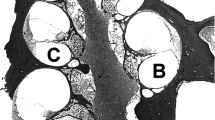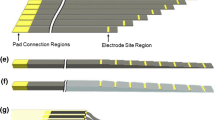Abstract
In patients with severe to profound hearing loss, cochlear implants (CIs) are currently the only therapeutic option when the amplification with conventional hearing aids does no longer lead to a useful hearing experience. Despite its great success, there are patients in which benefit from these devices is rather limited. One reason may be a poor neuron-device interaction, where the electric fields generated by the electrode array excite a wide range of tonotopically organized spiral ganglion neurons at the cost of spatial resolution. Coating of CI electrodes to provide a welcoming environment combined with suitable surface chemistry (e.g. with neurotrophic factors) has been suggested to create a closer bioelectrical interface between the electrode array and the target tissue, which might lead to better spatial resolution, better frequency discrimination, and ultimately may improve speech perception in patients. Here we investigate the use of a collagen surface with a cholesteric banding structure, whose orientation can be systemically controlled as a guiding structure for neurite outgrowth. We demonstrate that spiral ganglion neurons survive on collagen-coated surfaces and display a directed neurite growth influenced by the direction of collagen fibril deposition. The majority of neurites grow parallel to the orientation direction of the collagen. We suggest collagen coating as a possible future option in CI technology to direct neurite outgrowth and improve hearing results for affected patients.



Similar content being viewed by others
References
Chen GD (2006) Prestin gene expression in the rat cochlea following intense noise exposure. Hear Res 222:54–61
Lautermann J, Dehne N, Schacht J, Jahnke K (2004) Aminoglycoside- and cisplatin-ototoxicity: from basic science to clinics. Laryngorhinootologie 83:317–323
Liu XZ, Yan D (2007) Ageing and hearing loss. J Pathol 211:188–197
Schwander M, Sczaniecka A, Grillet N, Bailey JS, Avenarius M, Najmabadi H, Steffy BM, Federe GC, Lagler EA, Banan R, Hice R, Grabowski-Boase L, Keithley EM, Ryan AF, Housley GD, Wiltshire T, Smith RJ, Tarantino LM, Muller U (2007) A forward genetics screen in mice identifies recessive deafness traits and reveals that Pejvakin is essential for outer hair cell function. J Neurosci 27:2163–2175
Wilson BS, Dorman MF (2007) The surprising performance of present-day cochlear implants. IEEE Trans Biomed Eng 54:969–972
Wilson BS, Dorman MF (2008) Cochlear implants: current designs and future possibilities. J Rehabil Res Dev 45:695–730
Rothschild RM (2010) Neuroengineering tools/applications for bidirectional interfaces, brain–computer interfaces, and neuroprosthetic implants—a review of recent progress. Front Neuroeng 3:112
Jolly C, Garnham C, Mirzadeh H, Truy E, Martini A, Kiefer J, Braun S (2009) Electrode features for hearing preservation and drug delivery strategies. Adv Otorhinolaryngol 67:28–42
Pettingill LN, Richardson RT, Wise AK, O’Leary SJ, Shepherd RK (2007) Neurotrophic factors and neural prostheses: potential clinical applications based upon findings in the auditory system. IEEE Trans Biomed Eng 54:1138–1148
Tykocinski M, Cowan RS (2005) Poly-vinyl-alcohol (PVA) coating of cochlear implant electrode arrays: an in vivo biosafety study. Cochlear Implants Int 6:16–30
Richardson RT, Thompson B, Moulton S, Newbold C, Lum MG, Cameron A, Wallace G, Kapsa R, Clark G, O’Leary S (2007) The effect of polypyrrole with incorporated neurotrophin-3 on the promotion of neurite outgrowth from auditory neurons. Biomaterials 28:513–523
Volkenstein S, Brors D, Hansen S, Minovi A, Laub M, Jennissen HP, Dazert S, Neumann A (2009) Influence of bone morphogenetic protein-2 on spiral ganglion neurite growth in vitro. Eur Arch Otorhinolaryngol 266:1381–1389
Mutsaers SE, Bishop JE, McGrouther G, Laurent GJ (1997) Mechanisms of tissue repair: from wound healing to fibrosis. Int J Biochem Cell Biol 29:5–17
Leitinger B, Hohenester E (2007) Mammalian collagen receptors. Matrix Biol 26:146–155
Goffin JJ, Rajadas J, Fuller GG (2010) Interfacial flow processing of collagen. Langmuir 26:3514–3521
Kirkwood JE, Fuller GG (2009) Liquid crystalline collagen: a self-assembled morphology for the orientation of mammalian cells. Langmuir 25:3200–3206
Klein R (2009) Bidirectional modulation of synaptic functions by Eph/ephrin signaling. Nat Neurosci 12:15–20
Brors D, Bodmer D, Pak K, Aletsee C, Schäfers M, Dazert S, Ryan AF (2003) EphA4 provides repulsive signals to developing cochlear ganglion neurite smediated through ephrin-B2 and -B3. J Comp Neurol 462:90–100
Rubel EW, Fritzsch B (2002) Auditory system development: primary auditory neurons and their targets. Annu Rev Neurosci 25:51–101
Smeal RM, Tresco PA (2008) The influence of substrate curvature on neurite outgrowth is cell type dependent. Exp Neurol 213:281–292
Kofron CM, Liu YT, López-Fagundo CY, Mitchel JA, Hoffman-Kim D (2010) Neurite outgrowth at the biomimetic interface. Ann Biomed Eng 38:2210–2225
Pardridge WM, Wu D, Sakane T (1998) Combined use of carboxyl-directed protein pegylation and vector-mediated blood-brain barrier drug delivery system optimizes brain uptake of brain-derived neurotrophic factor following intravenous administration. Pharm Res 15:576–582
Acknowledgments
This work was supported by a BioX-grant of Stanford University to Drs. G.F., Frank Longo, and S.H., by Med-El Worldwide Headquarters Innsbruck, Austria, by the US National Institutes of Health grants DC06167 and P30 DC010363 to S.H., and by a postdoctoral fellowship of the Deutsche Akademie der Naturforscher Leopoldina (German Academy of Science, BMBF-LPD 9901/8-171) to S.V.
Conflict of interest
The authors declare that they have no conflict of interest.
Author information
Authors and Affiliations
Corresponding author
Rights and permissions
About this article
Cite this article
Volkenstein, S., Kirkwood, J.E., Lai, E. et al. Oriented collagen as a potential cochlear implant electrode surface coating to achieve directed neurite outgrowth. Eur Arch Otorhinolaryngol 269, 1111–1116 (2012). https://doi.org/10.1007/s00405-011-1775-8
Received:
Accepted:
Published:
Issue Date:
DOI: https://doi.org/10.1007/s00405-011-1775-8




